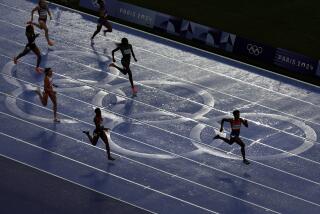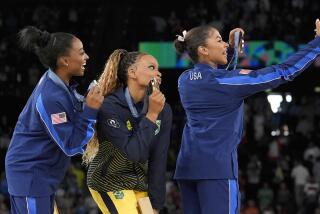No Bunny Hop
- Share via
BIG BEAR LAKE — A young man blasts “S” turns down Snow Summit and aims his board for a dangerously sloped launch pad. Whoomp, he’s off.
Silence. The nose of his snowboard gets impossibly above him. The ground comes swiftly, and, whack, he lands on his back.
Oooh. A small group of spectators feels his pain. His lungs are empty. Then, “Arrrhhh!” he lets it out, gets up and rides away.
Despite the hype, it’s not an easy sport. Down the hill, ski patrol has a “42” on its hands--a snowboarder down, this one with a laceration on his head. Last week, two snowboarders died near Lake Tahoe. One slammed into a tree and another was found face down in the snow. A third person was killed in a snowboarding accident this week near Donner Lake.
No place for “betties,” eh?
Back at the launch pad, Shawna Van Arsdale dials the jump, woosh, crouches in the thin air and nails the landing, thud, as fellow boarders hoot, fists up high.
This season, all eyes are on the women, from the winter sports media to the ski resorts to the snowboard companies, many of which have dollar signs in their sights. Ski Industries of America reports that nearly one in four snowboarders is female--and climbing. Women, in fact, are the fastest-growing segment of a fast-growing sport (nearly half of all snowboard rentals--a good indication of first-timers--go to women).
And in this pop explosion called snowboarding, where three-fourths of the riders are under 24, girls have become the bad boys of the slopes. They consistently do what the guys can do--and better.
“Some of these gals are hot,” says Snow Summit snowboarder and maintenance man Bill Rose, surveying the scene. He quickly clarifies, lest we get the wrong idea: “They’re exceptionally good boarders.”
What motivates young women to push themselves in a perilous pastime? The prevailing wisdom says snowboarding is at first hard to learn, but later easy to master. (Tell that to any one of the 26,000 people who reported snowboarding-related injuries last season). It doesn’t require a lot of upper-body strength. It does require strong legs. And it requires the flow and grace that some young women seem to have in abundance. “It’s a lot easier than skiing,” says 21-year-old UCLA senior Angelyn Wong, before pointing her board down the Snow Summit freestyle park, an icy white slope dotted with jumps.
“You can learn to snowboard and do fairly well after three or four days,” says an editor at Freeride, a new snowboard magazine based in Venice. “And it doesn’t require jumping into cold water or wearing rubber, which surfing requires.”
There’s also a social scene, which some women say has been more accepting because the sport is the product of a new generation of athletes and a new generation of thinking.
“There’s been a lot of discrimination for women who get into surfing or skateboarding, which are male dominated,” says Cristin Inglis, organizer of the second annual female snowboarder convention (“The Gathering of the Goddesses”), held in January in Snowbird, Utah. “Snowboarding is new enough that there’s not really that discrimination.”
“People in that generation were raised with the idea that men’s and women’s sports will be equal,” says a representative for SIA. “I don’t know a lot of snowboarding women who want to be snow bunnies. They’re out there busting big air with the guys.”
There is, as usual, a poseur factor.
“Some of the girls are out here for the same reasons as the guys--to look cool,” says Van Arsdale, 26 and a top-ranked amateur. “There’s so many of these girls out there with hardly any clothes on and it’s 20 degrees out. But they look great!”
There’s no end to betty bashing on the slopes--most often from the guys. A girl pearls in the snow, spreading gear across the slope, and she could hear the put-down, “Yard sale!” If she’s less than graceful taking a hit (going off a jump)--rotating her arms, say, for balance--someone might ask if she’s rolling down the windows or pulling a “flapper.” Then there’s the queen bee of slope insults: “Shred betty.”
“What betty is all about,” explains one expert, “is when a girl looks real good but can’t ride worth ----.”
“To me,” says a female snowboarder, “shred betty sounds degrading.”
Some shredders, however, have adopted the term.
“It’s an endearment,” says another. “Originally it meant you’re a girlfriend of guys who skate or surf. Now it means I ride out there with the guys.”
*
There is, of course, a fierce element in snowboarding. Young women don’t just ride out there with the guys, they ride against them. But the snowboard media portrays these hard-core riders as hard-core honeys who knock men out (with their looks) at the ski lodge. And, as Bethany Stevens, co-publisher of the first and only snowboarding ‘zine for women (Fresh and Tasty, based in Cambridge, Mass.) points out, “The guys are a little confused.”
“For us to do just as well as some of these guys out here,” Van Arsdale says, “is just as exciting as the sport itself. There are a lot of girls out there who are really anti-men because they’ve been dissed.”
But the shred betty image--the beautiful but skilled boarder--like most stereotypes, overshoots reality, women say.
“I think the media tends to skew the reality of snowboarding in a lot of different ways,” Inglis says. “Girls do it for the same reasons as the guys: It’s fun.”
Then there’s girl-versus-girl competition: “There’s a group of girls out here who feel they own the park,” says a 19-year-old rider. “If you cut them off, look out. . . .”
Women have been in the sport since the Sno-Surfer (a sort of stand-up toboggan) started it all back in 1964. In snowboarding’s formative years, Beverly Sanders co-founded one of the first companies to manufacture snowboards exclusively, Avalanche, back in 1985. Today, as snowboarding takes its place as an Olympic event, women compete in all categories, at the highest skill levels.
Big money beckons riders who need sponsors--even women who want to turn pro. Pro sponsors include Burton, Simms and K2 snowboards, as well as Levi’s and Pepsi (there’s even Betty Clothing, “For Girls Who Ride”). Companies see a growing market of nearly 500,000 women snowboarders, and an even bigger market of women who want to buy slope-inspired fashions.
There are, say scene watchers, two schools of winter wear: “Technical,” or fashion that’s functional when it comes to riding (often baggy and masculine in feel), and girlie wear that stresses style (fur, tighter-fitting gear and midriff exposure). There are even schools of sound associated with snowboarding, most often punk rock and suburbanized hip-hop (Beastie Boys, Luscious Jackson).
“Snowboarding is very much a lifestyle sport like surfing or skateboarding,” says Ali Zacaroli, snowboarder and spokeswoman for SIA. “Women can surround their life with it, what they wear, what they listen to, who they hang out with.”
*
Which brings up an age-old problem that snowboarding women seem to be battling better than female athletes of the past.
“You see men in ads, and they’re riding,” says Amy Nation, co-publisher of Freeride. “You see women, and they’re posing. The objectification of women is a huge issue. It’s really important that women are portrayed as riders and not just fashion victims.”
Up on Snow Summit, on a 37 degree day so clear it hurts, victims they’re not. Girl after girl bombs the mountain with abandon. Life is good. As far as the eye can see, the only sore spot is the lift line--sure to get longer as more women long to join in.
Van Arsdale scans the scene with her keen blue eyes. There are teenage girls with pink boards everywhere. She ponders the overcrowding and proclaims, “I guess I get kinda bummed.”
More to Read
Go beyond the scoreboard
Get the latest on L.A.'s teams in the daily Sports Report newsletter.
You may occasionally receive promotional content from the Los Angeles Times.










